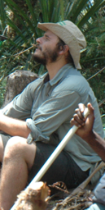Phytochemical journeys: from lowlands to highlands in New Guinea

Simon T. Segar
Harper-Adams University, United Kingdom
ssegar@harper-ada
ms.ac.uk
Tropical forest trees and their associated insect fauna are one of the most diverse sets of biota on earth. Complex networks of insects on plants exist in a rich chemical landscape. Here I present a body of recent work from New Guinea which focuses on i) predicting the host plant use of caterpillars across a diverse selection of plant families, ii) using more detailed chemical data to partition the traits shaping the communities of insects on figs and iii) studying the investment into chemical defence made by figs growing along a wet tropical mountain. Our models predict caterpillar host use with enough accuracy to shed light on the traits and processes driving patterns of diversification. Furthermore, a complex selective landscape along steep environmental gradients is reflected in species-specific trends in chemical defence and a cascading influence on insect herbivore communities. Overall, this work contributes to a developing synthesis of how trait evolution shapes insect-plant interactions in large and locally dominant tropical tree genera.
Recent publications:
Segar et al. (2020). The role of evolution in shaping ecological networks. Trends in Ecology and Evolution 35: 454-466.
Souto-Vilaros et al. (2019). Faster speciation of fig‐wasps than their host figs leads to decoupled speciation dynamics: snapshots across the speciation continuum. Molecular Ecology 28 (17): 3958-3976.
Volf et al. (2018) Community structure of insect herbivores is driven by conservatism, escalation and divergence of defensive traits in Ficus. Ecology Letters 21(1): 83-92.



